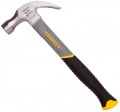Head weight
The weight of the striker in this case means the weight of the entire head — the working part of the hammer, put on the handle. The overall weight of the tool is also affected by the handle (sometimes quite significantly), but the performance is almost entirely determined by the weight of the head. Therefore, it is this indicator that is usually indicated in the characteristics and it is he who is meant when talking about the weight of the hammer as a whole.
Each type of hammer (see "Type") has its own weight range: for example, carpentry hammers are available in the weight category from
100 g to 1 kg, metalwork — up to
2 kg, and the weight of sledgehammers starts at about
1 kg and often exceeds
10 kg. In special sources, you can find detailed recommendations on the choice of weight depending on the type and planned features of the application. Here we note that, all other things being equal, a larger weight has a positive effect on the impact force, a smaller one contributes to accuracy and accuracy.
Length
The total length of the hammer. This parameter is selected by the manufacturer based on the type (see above) and the “weight category” of the tool, however, models that are similar in characteristics may have different lengths. In such cases, it is worth taking into account that longer hammers are more "sweeping", they provide more impact force; shorter ones, in turn, are better suited for precision work, and also weigh less. Detailed recommendations on choosing the optimal length for each specific case can be found in special sources.
Hammer face size
The size of the striker is actually the shock part of the head. For round strikers, the diameter is usually indicated, for square strikers, the length of the side of the square; there are also rectangular strikers (in particular, in mallets — see "Type") — for them the size is given in length and width.
The size of the striker is usually chosen in accordance with the type and weight of the tool, so most often this parameter is more of a reference than of practical significance. However, in some situations it is also worth paying attention to — for example, if we are talking about a straightening hammer or mallet used for the same purposes. In this application, a larger striker allows you to quickly deal with a large area, a smaller one provides better accuracy and accuracy.
Handle material
—
Tree. "Classic of the genre", not losing popularity in our days. At a low cost, the tree sits securely in the hand; its strength is noticeably lower than that of metal, but this can be compensated for by the thickness of the handle — especially since the weight of this material is relatively small and allows this. So in most cases, strength is enough; and even if the handle is broken, it can be replaced with another one, all wooden handles are technically removable (except in mallets it can be easier to buy a new tool than to repair a broken one).
—
Metal. Metal handles are usually made of tool steel — the same as used in strikers (although the striker itself is not necessarily steel). The main advantage of this material is high strength and reliability: it is very difficult to break a metal handle, even if you specifically set yourself such a goal. On the other hand, metal costs a little more than wood, and therefore is less common. Also note that the steel surface itself tends to slip in the hand; therefore, all steel handles must be made rubberized (see below).
—
Fibreglass. Usually, in this case, not pure fibreglass is meant, but fibreglass (fibreglass) — a material made of thin glass filaments and a binding plastic. This combination allows you to achieve very high strength (in some grades — comparable to steel) with low weight and affordable cost. Due
...to this, fibreglass handles are very widely used in modern hammers, only slightly inferior in popularity to wooden ones. And they are significantly superior to classic plastic ones.
— Rubber. A rather specific option, found mainly in models with a monolithic design (see below). If the design is not monolithic, then this option means a rubberized handle (also see below), which is covered with rubber along the entire length, up to the very head. Anyway, the rubber itself is too soft to be used as a standalone material. Therefore, it is used as an outer coating for a rigid (usually metallic) substrate. The advantages of such handles are similar to rubber ones — first of all, it is the convenience and reliability of holding in the hand.
— Graphite. This option usually means a handle made of durable plastic (polycarbonate), inside which a graphite rod is installed. The composition of graphite is selected in such a way that such a combination provides very high strength — comparable to steel, with greater convenience and less weight. The plastic surface is not very secure to hold, so the handle is usually rubberized (see below).
— Plastic. The plastic handle makes the hammer lighter. The main advantage of plastic is resistance to moisture. Such hammers will not wear, and therefore the strength of the impact tool will not decrease. A special grade of plastic is used for the manufacture, which makes the handle more durable than natural wood. The vast majority of hammers with a plastic handle are equipped with a rubberized surface in the grip area. The presence of an additional coating prevents the tool from slipping out of the hands during operation.
